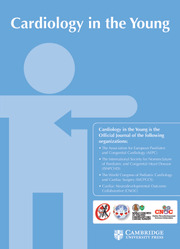CHD remains one of the leading causes of child mortality globally, with a significant burden in low- and middle-income countries. The Global Burden of Disease Study 2023 reported a slight increase in CHD prevalence from 1.8% in 2017 to 1.9% in 2023, largely due to improved diagnostic capabilities in high-income countries. 1 However, this improved detection has not been mirrored in low- and middle-income countries, where an estimated 85% of CHD cases remain undiagnosed or untreated. Reference Zimmerman, Smith and Sable2 The COVID-19 pandemic has further exacerbated these disparities, with CHD-related child mortality in low- and middle-income countries rising by 12% from 2019 to 2023 due to healthcare system strain, delays in referrals, and reduced surgical access. 3 This highlights the need for a multi-faceted approach to address the global gap in paediatric cardiac care. To mitigate these challenges, Hasan et al. proposed a three-tiered paediatric cardiac care framework adaptable to varying resource settings, including Tier 1- Community-based primary centres utilising pulse oximetry for newborn screening, Tier 2-Regional hubs staffed by trained paediatricians and equipped with echocardiography, Tier 3-National or state tertiary centres capable of advanced surgical and postoperative care. Reference Hasan, Bhatti and Mohsin4 This framework has the potential to improve early detection and treatment of CHD, particularly in low- and middle-income countries. However, its implementation requires careful planning, resource allocation, and training of healthcare professionals.
Technological advancements, such as artificial intelligence, can enhance this model. Artificial intelligence-supported platforms deployed in under-resourced Tier 2 hubs can significantly reduce delays in detecting CHD, facilitating earlier interventions and improving clinical outcomes. Artificial intelligence-powered prediction models can also support prenatal diagnosis, risk stratification, and postoperative management. Reference Sethi, Patel and Kaka5 For example, a study in rural India found that artificial intelligence-assisted diagnostics reduced diagnostic delays by nearly 50%. 6 The integration of artificial intelligence in paediatric cardiac care has the potential to revolutionise the field. Artificial intelligence can help analyse large amounts of data, identify patterns, and make predictions, enabling healthcare professionals to make informed decisions and provide personalised care. However, the adoption of artificial intelligence also raises concerns about data quality, algorithmic bias, and depersonalisation of care. Addressing these disparities also requires reform in medical education and training. The adoption of competency-based medical education and technology-enhanced instruction can help bridge the gap in paediatric cardiac care. Reference Mcmahon, Tretter and Redington7 Global training standards in congenital cardiology are inconsistent, and there is a critical need for harmonised curricula and assessment strategies tailored to local population needs. Reference Mcmahon, Tretter and Redington7 Medical education and training programmes should focus on developing the skills and competencies of healthcare professionals in paediatric cardiac care. This includes training in pulse oximetry, echocardiography, and advanced surgical and postoperative care. Additionally, programmes should emphasise the importance of teamwork, communication, and cultural competence in providing high-quality care. India’s Rashtriya Bal Swasthya Karyakram exemplifies how public–private partnerships can expand paediatric cardiac services. In 2023 alone, the programme screened 27 million children and supported over 12,000 life-saving surgeries, demonstrating the potential of collaborative models to scale equitable care. 8 Public–private partnerships can play a critical role in improving paediatric cardiac care in low- and middle-income countries. By leveraging the resources and expertise of both public and private sectors, public–private partnerships can help increase access to care, improve quality of services, and reduce costs. However, public–private partnerships also require careful planning, management, and evaluation to ensure that they are effective and sustainable.
Non-governmental organisations have played a significant role in supporting paediatric cardiac care in low- and middle-income countries. However, there is a need for greater transparency in impact metrics and the importance of transitioning toward locally sustainable cardiac programs. Reference Vervoort, Guetter and Munyaneza9 A study by Vervoort et al. identified 86 active non-government organisations delivering cardiac surgical services across 111 countries, most of them low- and middle-income countries. Reference Vervoort, Guetter and Munyaneza9 Non-government organisations can provide critical support to paediatric cardiac care programs in low- and middle-income countries. By providing funding, technical assistance, and capacity-building programs, non-government organisations can help improve the quality and accessibility of care. However, non-government organisations should also prioritise sustainability, transparency, and accountability in their programmes.
In conclusion, addressing the global gap in paediatric services requires a multi-faceted approach. To bridge this gap, low- and middle-income countries must adopt policies that ensure universal newborn screening with pulse oximetry,integration of CHD-focused training in primary care curricula,establishment of national CHD registries for real time data driven planning. Scaling public–private partnerships,subsidising surgeries for low-income families, and investing in artificial intelligence-assisted diagnostics at regional hubs can dramatically improve early detection and equitable access to life saving interventions. With political will and strategic innovation, no child should be denied care because of where they are born.


